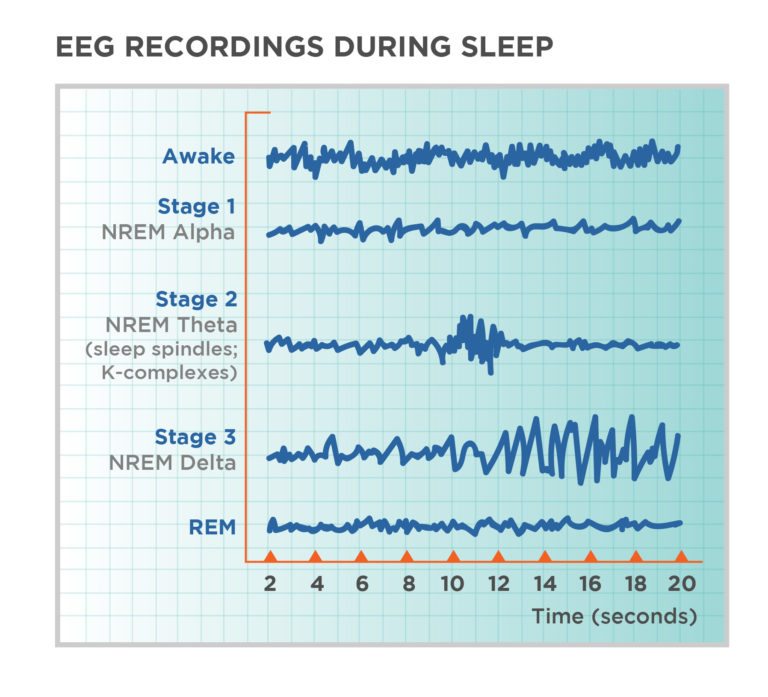Sleep
The 5 Stages of Sleep Uncovered
 Did you know there are 5 stages of sleep that you can go through on any given night? Many of us have noticed that depending on how much sleep we get for the night, or the quality of sleep we get, will affect us dramatically the following day. This is because of our sleep cycles, or our stages of sleep. During each phase, our body and brainwaves react differently, directly linked to energy and exhaustion levels. There are five total stages of sleep and a few keywords to know when diving into this knowledge.
Did you know there are 5 stages of sleep that you can go through on any given night? Many of us have noticed that depending on how much sleep we get for the night, or the quality of sleep we get, will affect us dramatically the following day. This is because of our sleep cycles, or our stages of sleep. During each phase, our body and brainwaves react differently, directly linked to energy and exhaustion levels. There are five total stages of sleep and a few keywords to know when diving into this knowledge.
What is REM?
REM stands for rapid eye movement. When we sleep, our eyes naturally move but don’t send the visual information to our brains for interpretation. During non-REM sleep, your eyes do not move, and you are in a lighter sleep cycle. Each phase of sleep has a different cycle of REM or non-REM, coordinating with how deep of sleep we are in. Usually, REM occurs around 90 minutes after falling asleep, and approximately 75% of sleep is spent in non-REM sleep.
What are EEG waves?
EEG refers to an electroencephalogram test that monitors and visualizes our brain waves. How does this relate to sleep? When we sleep, our brain activity changes. Using an EEG, we can see what patterns can be seen in each stage. This is helpful for those with sleep difficulties, brain disorders, and epilepsy.

There are 5 Stages of Sleep:
Stage One
In the first stage, our body is in non-REM sleep. This is also sometimes referred to as the ‘wake’ stage. This stage takes us from our waking state into a light rest or the beginning of rest. Our bodies begin to slow down and unwind, with our heartbeat slowing and decreased muscle tension. With brain wave activity, we see similar activity to being in a relaxed and wake state.Stage Two
Stage two is a more relaxed state than stage one. This is also non-REM sleep. Time asleep will mostly be in this stage. You can be awakened easily but are not yet in a deep sleep. Your heartbeat, breathing, and temperature will decrease. Usually, you will be in this stage for a half hour less. On an EEG, we see two different brain waves, sleep spindles and K-complexes. A K-complex is a high amplitude brain wave and brain activity that often respond to external stimuli in a heightened sense. These waves help maintain sleep and memory consolidation. Sleep spindles are brief bursts of neurons that also help with memory consolidation.Stage Three
In this stage, your EEG would record lower frequency waves. This is the deepest stage of sleep but is still considered non-REM. If you know of somebody who is very difficult to wake, they are likely in this stage of sleep. When we get older, we spend less time in stage three, when sleeping dysfunctions like bedwetting, sleepwalking, or night terrors may occur. If you are awakened during this stage, you will feel groggy or foggy-headed, otherwise known as sleep inertia. An interesting aspect of this stage is that our bodies repair themselves when sleeping, building bone and muscle and strengthening our immune system. Our heartbeats and breathing are at their slowest rate, you will not have eye movement, and cell regeneration occurs.Stage Four
Some professionals place stages four and three together as they are very similar. They both are deep sleep and can be referred to as ‘slow wave sleep,’ or delta sleep, by the brain wave patterns they produce. Stage four can also be broken down into two sections, phasic and tonic. Phasic means our eyes will have bursts of movement, whereas tonic does not.Stage Five
Stage five is REM sleep and is the stage where we most often dream, although it may not necessarily be restful. An EEG would look like waketime, but our bodies do not. Our breathing is not as stable as in other stages, and our heart rate may increase instead of decrease. REM ignites the areas of our brain that are associated with learning and high activity. There are different REM sleep stages, with the initial stage lasting about ten minutes and the later stage at around 90 minutes. You will continue to be difficult to wake, and you will likely wake spontaneously.What Affects Our Stages of Sleep?
Many things can affect your sleep. Examples include age, sleep patterns, sleep disorders, and medications. Newborns spend approximately 50% of their time sleeping in REM sleep, which starts to fade away as we age, with elderly people spending the least time in REM sleep. If you consume a lot of alcohol or caffeine, you will find this impacts your sleep, particularly when trying to fall asleep. Some prescription medications like diuretics may interrupt sleep more often due to the need to urinate frequently. While over-the-counter medications are helpful for some, they may cause daytime grogginess.Maximizing Sleep Cycles
Some things that affect sleep, like our habits or sleeping conditions, can be changed to have more optimal rest. Keep your sleeping area dark and quiet, and minimize the use of electronics or caffeine before bed. Try to avoid long naps that could interrupt your normal sleeping times. Eating before bed, or having nighttime snacks, may also impact your sleep quality or cause disruptions like acid reflux.Moving Forward
If you have consistent trouble sleeping, speak with your physician about what you are experiencing. Taking longer than 30 minutes to fall asleep is usually an indicator of poor sleep quality and should be monitored. Many people have conditions like insomnia or snoring, which can be an ongoing issue and impact your daily life. If you suspect you may have sleep issues, you can start a sleep diary to track how you feel when you wake up, and many times you woke up. You can also use a watch with a sleep tracker. Discuss your findings with your physician to work towards high-quality sleep.Like? Share with your friends
Learn More Information on How Somni Can Offer You a Better Sleep Experience*

